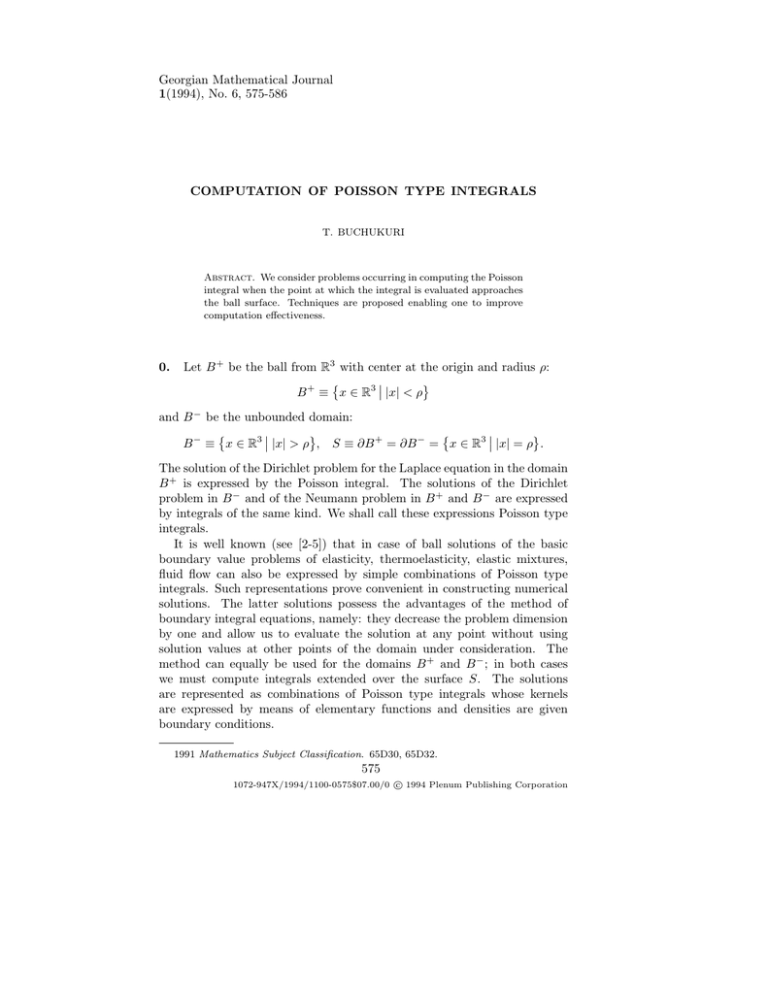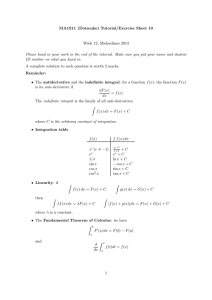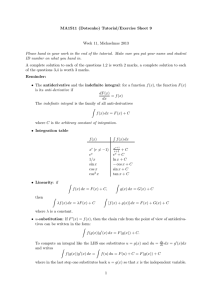Georgian Mathematical Journal 1(1994), No. 6, 575-586 COMPUTATION OF POISSON TYPE INTEGRALS
advertisement

Georgian Mathematical Journal
1(1994), No. 6, 575-586
COMPUTATION OF POISSON TYPE INTEGRALS
T. BUCHUKURI
Abstract. We consider problems occurring in computing the Poisson
integral when the point at which the integral is evaluated approaches
the ball surface. Techniques are proposed enabling one to improve
computation effectiveness.
0.
Let B + be the ball from R3 with center at the origin and radius ρ:
B + ≡ x ∈ R3 |x| < ρ
and B − be the unbounded domain:
B − ≡ x ∈ R3 |x| > ρ , S ≡ ∂B + = ∂B − = x ∈ R3 |x| = ρ .
The solution of the Dirichlet problem for the Laplace equation in the domain
B + is expressed by the Poisson integral. The solutions of the Dirichlet
problem in B − and of the Neumann problem in B + and B − are expressed
by integrals of the same kind. We shall call these expressions Poisson type
integrals.
It is well known (see [2-5]) that in case of ball solutions of the basic
boundary value problems of elasticity, thermoelasticity, elastic mixtures,
fluid flow can also be expressed by simple combinations of Poisson type
integrals. Such representations prove convenient in constructing numerical
solutions. The latter solutions possess the advantages of the method of
boundary integral equations, namely: they decrease the problem dimension
by one and allow us to evaluate the solution at any point without using
solution values at other points of the domain under consideration. The
method can equally be used for the domains B + and B − ; in both cases
we must compute integrals extended over the surface S. The solutions
are represented as combinations of Poisson type integrals whose kernels
are expressed by means of elementary functions and densities are given
boundary conditions.
1991 Mathematics Subject Classification. 65D30, 65D32.
575
c 1994 Plenum Publishing Corporation
1072-947X/1994/1100-0575$07.00/0
576
T. BUCHUKURI
Methods of computing such integrals do not actually differ from those
commonly used in computing two-dimensional integrals. Nevertheless they
need a certain modification so that they could lead to effective algorithms
for computing Poisson type integrals. In particular, difficulties arise when
integrals are computed at points close to the surface S because at these
points the kernels of integrals have strong singularities.
1. In computing integrals which are solutions of the considered boundary
value problems we come across the same difficulty as in the case of the
Poisson integral regarded as the simplest one among integrals of this kind.
Let u be the solution of the Dirichlet problem for the ball B + :
∀x ∈ B + : ∆u(x) = 0,
∀y ∈ S : u+ (y) = f (y),
where f is a given function on S. Then u can be represented by the Poisson
formula
1 − τ2
u(ρ0 , ϑ0 , ϕ0 ) =
4π
Zπ Z2π
0
0
sin ϑ
fe(ϑ, ϕ)dϕdϑ.
(1 − 2τ cos γ + τ 2 )3/2
(1)
Here (ρ0 , ϑ0 , ϕ0 ) and (ρ, ϑ, ϕ) are the spherical coordinates of the points
x0 ∈ B + and y ∈ S;
x01 = ρ0 cos ϕ0 sin ϑ0 , x20 = ρ0 sin ϕ0 sin ϑ0 , x30 = ρ0 cos ϑ0 ;
y1 = ρ cos ϕ sin ϑ, y2 = ρ sin ϕ sin ϑ, y3 = ρ cos ϑ,
γ is the angle between the vectors x0 and y,
τ = ρ0 /ρ , fe(ϑ, ϕ) ≡ f (ρ cos ϕ sin ϑ, ρ sin ϕ sin ϕ, ρ cos ϑ).
To compute the integral (1) it is convenient to represent it as an iterated
integral and to use any of the quadrature formulae for one-dimensional
integrals (in our case this will be Simpson’s formula; see, for example, [6]).
2.
In computing the integral
Zb
f (t) dt
(2)
a
by Simpson’s method, its value is approximately replaced by the sum
S(f, a, b, m) ≡
m−1
X
h
f (a + 2kh) +
f (a) + f (b) + 2
3
+4
k=1
m−1
X
k=0
where h ≡
b−a
2m .
f a + (2k + 1)h ,
(3)
COMPUTATION OF POISSON TYPE INTEGRALS
577
Note that (3) contains the value of f at the 2m + 1 points: t = a,
t = a + h, . . . , t = a + (2m + 1)h, t = b.
Denote the error of Simpson’s formula by R(h):
R(h) ≡
Zb
a
f (t)dt − S(f, a, b, m).
(4)
(b − a)h4 (4)
f (ξ)
180
(5)
If f ∈ C 4 ([a, b]), then [6]
R(h) = −
for some ξ ∈]a, b[. Thus to estimate the error we obtain
|R(h)| ≤
(b − a)h4
max f (4) (ξ).
a≤ξ≤b
180
(6)
The estimate (6) is rather crude and its application may lead to a substantial increase of m in the sum (3). This happens particularly when f (4)
sharply increases in the neighborhood of some point of [a, b]. It will be shown
below that the same situation occurs in computing Poisson type integrals.
In practice, the error is frequently estimated using Runge’s principle [6]
which is as follows: If the condition
σ ≡ S(f, a, b, 2m) − S(f, a, b, m) ≤ ε
(7)
is fulfilled for some m, then S(f, a, b, 2m) is taken as an approximate value
of integral (2) and the number ε for the error. As has been established, for
σ
.
Simpson’s formula the error can be estimated by R(h) ≈ 15
3. To compute the integral (1) the above-mentioned procedure of replacing
the one-dimensional integral by the sum (3) should be applied twice. Let
us estimate the error for either of the cases so that the computational error
for the integral (3) be not greater that ε.
e a, b, δ) sum (3) for m such that
Denote by S(f,
Zb
f (t) dt − S(f, a, b, m) ≤ δ.
(8)
a
From (6) it follows that for the fulfilment of (8) it is sufficient to take
m≥
1/4 −1/4
(b − a)5/4
δ
max |f (4) (ξ)|
.
1/4
a≤ξ≤b
2 · 180
(9)
578
T. BUCHUKURI
Denote by F the function
F (ϑ, ϕ) ≡ K(τ, ϑ, ϕ)fe(ϑ, ϕ),
K(τ, ϑ, ϕ) ≡
sin ϑ
(1 − 2τ cos γ + τ 2 )3/2
and by I the integral
I(ϑ) ≡
Z2π
F (ϑ, ϕ) dϕ.
0
Now (1) can be rewritten as
1 − τ2
u(ρ0 , ϑ0 , ϕ0 ) =
4π
Zπ
0
I(ϑ) dϑ.
(10 )
Due to (8) and (9) we have
where
e
≤ δ1 ,
|I(ϑ) − I(ϑ)|
(10)
e
e (ϑ, ·), 0, 2π, δ1 ) = S(F (ϑ, ·), 0, 2π, m1 ),
I(ϑ)
≡ S(F
(2π)5/4
∂ 4 F (ϑ, ϕ) 1/4 −1/4
.
m1 ≥
δ1
max
∂ϕ4
2 · 1801/4 ϑ,ϕ
(11)
Let u
e(ρ0 , ϑ0 , ϕ0 ) be an approximate value of integral (10 ):
Then
u
e(ρ0 , ϑ0 , ϕ0 ) ≡
1 − τ2 e e
S(I, 0, π, δ2 ).
4π
1 − τ 2
|u(ρ0 , ϑ0 , ϕ0 ) − u
e(ρ0 , ϑ0 , ϕ0 )| ≤
4π
Zπ
0
I(ϑ) dϑ −
2
e 0, π, δ2 )|,
e I,
e 0, π, δ2 )dϑ + 1 − τ |S(I,
e 0, π, δ2 ) − S(
S(I,
4π
e 0, π, δ2 ) ≡ S(I, 0, π, m2 ),
S(I,
∂ 4 F (ϑ, ϕ) 1/4
π 3/4
−1/4
m2 ≥
δ2
.
max
∂ϑ4
2 · 1801/4 ϑ,ϕ
(12)
(13)
The first term on the right-hand side of (12) is less than (1 − τ 2 )δ2 /(4π).
Let us estimate the second term. Note that
|S(f, a, b, m)| ≤ (b − a) max |f (x)|.
a≤x≤b
COMPUTATION OF POISSON TYPE INTEGRALS
579
Therefore
e 0, π, δ2 ) − S(
e 0, π, δ2 )| ≤ π max |I(ϑ) − I(ϑ)|
e I,
e
|S(I,
≤ πδ1 .
0≤ϑ≤π
Now (12) yields
If
|u(ρ0 , ϑ0 , ϕ0 ) − u
e(ρ0 , ϑ0 , ϕ0 )| ≤
δ1 = δ2 =
we finally obtain
1 − τ2
(δ2 + πδ1 ).
4π
4πε
,
(1 − τ 2 )(π + 1)
|u(ρ0 , ϑ0 , ϕ0 ) − u
e(ρ0 , ϑ0 , ϕ0 )| ≤ ε.
From (11) and (13) it follows that the number of nodes N required that
a given accuracy ε be achieved is estimated as follows:
N = m1 m2 = c0 c(F )(1 − τ )1/2 ε−1/2 .
(14)
where c0 does not depend on F and
c(F ) =
∂ 4 F (ϑ, ϕ)
∂ 4 F (ϑ, ϕ) 1/4
max
.
· max
4
4
ϑ,ϕ
ϑ,ϕ
∂ϕ
∂ϑ
(15)
Below c will denote an arbitrary positive constant.
4. In practice it is important to know the values of the Poisson integral
at points close to the boundary. But when the point x0 = (ρ0 , ϑ0 , ϕ0 )
approaches the boundary S = ∂B(0, ρ), in computing the values of the
Poisson integral at the point x0 by the above-described method, we observe
a sharp increase of the number of nodes at which the function f is evaluated,
and, accordingly, nearly the same increase of the computational time. We
shall show why this happens.
Let A ≡ (1 − 2τ cos γ + τ 2 )1/2 , then
A2 = (1 − τ )2 + 4τ sin2
γ
> (1 − τ )2
2
and 1/A < 1/d, where d ≡ 1 − τ . Moreover, if
γ
d
< √
,
2
2 1−d
√
then A2 < 2(1 − τ )2 and 1/A > 1/ 2 d. Hence we conclude that 1/A has
order 1/d for small γ.
Let us now estimate fourth order derivatives of F .
sin
580
T. BUCHUKURI
Assume that
∂ α+β fe(ϑ, ϕ)
∀(ϑ, ϕ) ∈ [0, π] × [0, 2π] :
≤ c, α + β ≤ 4.
∂ϑα ∂ϕβ
(16)
Since γ is the angle between the vectors x0 and y, we have either |ϑ−ϑ0 | ≤ γ
and |ϕ − ϕ0 | ≤ γ or 2π − γ < |ϕ − ϕ0 | < 2π. Therefore
d
| sin(ϕ − ϕ0 )| ≤ √
,
2 1−d
d
| sin(ϑ − ϑ0 )| ≤ √
.
2 1−d
Hence we conclude that if 0 ≤ α ≤ 4, then
1
∂ α K(τ, ϑ, ϕ)
∼ α+3 ,
∂ϕα
d
and therefore
for
4
∂ F (ϑ, ϕ)
∼ 1,
∂ϕ4 d7
∂ α K(τ, ϑ, ϕ)
1
∼ α+3 ,
∂ϑα
d
∂ 4 F (ϑ, ϕ)
∼ 1
∂ϑ4
d7
(17)
γ
d
≤ √
.
2
2 1−d
From (14), (15) and (17) we obtain
sin
Theorem 1. The number of nodes required that a given accuracy be
achieved in formula (1) admits the estimate
N (d) = O(d−3 ).
(18)
This theorem explains the phenomenon of an increasing number of nodes
as the point x0 approaches the boundary S.
5. Now let us find how for a given accuracy we can decrease the number of
nodes and, accordingly, the computational time when the point x0 is near
the boundary. This can be accomplished in different ways. One of the ways
of reducing nodes is the so-called method of separation of singularities. To
realize this method note that the identity
1 − τ2
4π
Zπ Z2π
0 0
sin ϑ
dϕ dϑ = 1
(1 − 2τ cos γ + τ 2 )3/2
(19)
is obviously valid and therefore (1) can be rewritten as
1 − τ2
u(ρ0 , ϑ0 , ϕ0 ) = fe(ϑ0 , ϕ0 ) +
4π
Zπ Z2π
0 0
F1 (ϑ, ϕ) dϕ dϑ,
(20)
COMPUTATION OF POISSON TYPE INTEGRALS
581
with
F1 (ϑ, ϕ) =
sin ϑ
(fe(ϑ, ϕ) − fe(ϑ0 , ϕ0 )).
(1 − 2τ cos γ + τ 2 )3/2
Lagrange’s theorem implies
|fe(ϑ, ϕ) − fe(ϑ0 , ϕ0 )| ≤ cγ.
for
This makes it possible to improve the error estimate, since
4
4
∂ F1 (ϑ, ϕ) ∼ 1 , ∂ F1 (ϑ, ϕ) ∼ 1
4
6
4
∂ϕ
d
∂ϑ
d6
sin
and therefore
γ
d
,
< √
2
2 1−d
N (d) = O(d−5/2 ).
(21)
A further improvement of the method can be effectively achieved by the
rotation of the coordinate system.
6. Let x0 ∈ B + \{0}. Denote by Ax0 the following transformation of the
Cartesian coordinates y = (y1 , y2 , y3 ).
Ax0 (y) 1 =
(x10 )2
x0 x0
−
1
y1 + 0 10 2 0 y2 +
0
0
0
|x |(|x | + x3 )
|x |(|x | + x3 )
0 0
(x20 )2
x x
Ax0 (y) 2 = 0 10 2 0 y1 +
−
1
y2 +
|x |(|x | + x3 )
|x0 |(|x0 | + x03 )
x0
x0
x0
Ax0 (y) 3 = 1 y1 + 2 y2 + 3 y3
|x|
|x|
|x|
x01
y3 ,
|x|
x02
y3 ,
|x|
for x03 ≥ 0 and
Ax0 (y) 1 = 1 −
(x01 )2
x01
x01 x02
y
−
+
y3 ,
y
1
2
0
0
|x0 |(|x0 | − x3 )
|x0 |(|x0 | − x3 )
|x|
x0 x0
x02
(x02 )2
Ax0 (y) 2 = − 0 10 2 0 y1 + 1 − 0
y
+
y3 ,
2
|x |(|x | − x3 )
|x |(|x0 | − x03 )
|x|
x0
x0
x0
Ax0 (y) 3 = 1 y1 + 2 y2 + 3 y3 .
|x|
|x|
|x|
Now we have
582
T. BUCHUKURI
Theorem 2. Let x0 ∈ B + \{0}. Then u(x0 ) = u(ρ0 , ϑ0 , ϕ0 ) from (1)
can be written as
1 − τ2
u(ρ0 , ϑ0 , ϕ0 ) = fe(ϑ0 , ϕ0 ) +
4π
×
where
g(y) ≡ f Ax0 (y) ,
Z2π
0
Zπ
0
sinϑ
×
(1 − 2τ cos γ + τ 2 )3/2
ge(ϑ, ϕ) dϕ − 2π fe(ϑ0 , ϕ0 ) dϑ,
(22)
ge(ϑ, ϕ) = g(ρ cos ϕ sin ϑ, ρ sin ϕ sin ϑ, ρ cos ϑ).
Proof. As one can easy verify, for any fixed x0 ∈ B + \{0} the transformation Ax0 is the rotation of the coordinate system transforming the point
e0 = (0, 0, |x0 |) into the point x0 . Therefore v(x) = u(Ax0 (x)) is a harx
monic function taking on S the boundary value g(y). Moreover, in terms of
spherical coordinates we shall have
v(ρ0 , 0, 0) = u(ρ0 , ϑ0 , ϕ0 ),
ge(0, 0) = fe(ϑ0 , ϕ0 ).
Now apply (20) to the function v at the point (ρ0 , 0, 0). Note that in the
case under consideration γ = ϑ. Therefore the kernel K does not depend on
ϕ and can be put outside the internal integral. Then (20) gives (22).
Now let us estimate the number of nodes required for the computation
of u(ρ0 , ϑ0 , ϕ0 ) by formula (22).
Theorem 3. The number of nodes required that a given accuracy be
achieved in computing u(ρ0 , ϑ0 , ϕ0 ) by (22) admits the estimate
N (d) = O(d−1 ).
Proof. We introduce the notation
I1 (ϑ) ≡
Z2π
0
ge(ϑ, ϕ) dϕ − 2π fe(ϑ0 , ϕ0 ),
e g (ϑ, ·), 0, 2π, δ1 ) − 2π fe(ϑ0 , ϕ0 ),
Ie1 (ϑ) ≡ S(e
1 − τ 2 e
u
e(ρ0 , ϑ0 , ϕ0 ) = fe(ϑ0 , ϕ0 ) +
S K(τ, ·)Ie1 , 0, π, δ2 .
4π
(23)
COMPUTATION OF POISSON TYPE INTEGRALS
583
Then
Zπ
1 − τ2
|u(ρ0 , ϑ0 , ϕ0 )−e
K(τ, ϑ)|I1 (ϑ)− Ie1 (ϑ)|dϑ+
u(ρ0 , ϑ0 , ϕ0 )| ≤
4π
0
π
Z
2
1−τ
e1 (ϑ)dϑ − S(K(τ,
e
e1 , 0, π, δ2 ) .
+
K(τ,
I
ϑ)
·)
I
4π
0
Since
1 − τ2
4π
Zπ
0
K(τ, ϑ) dϑ =
1
,
2π
we obtain
δ1
1 − τ2
u(ρ0 , ϑ0 , ϕ0 ) − u
+
δ2 .
e(ρ0 , ϑ0 , ϕ0 ) ≤
2π
4π
Choosing δ1 = πε, δ2 = 2πd−1 ε, we have
u(ρ0 , ϑ0 , ϕ0 ) − u
e(ρ0 , ϑ0 , ϕ0 ) ≤ ε.
Let
e g (ϑ, ·), 0, 2π, δ1 ) = S(e
g (ϑ, ·), 0, 2π, m1 ),
S(e
e
S(K(τ,
·), Ie1 , 0, π, δ2 ) = S(K(τ, ·), Ie1 , 0, π, m2 ),
Then by (11) and (16) m ≥ cε−1/4 .
Now we shall estimate m2 . Taking into account (9), we obtain
m2 ≥ c
∂4
1/4 1/4 −1/4
,
d ε
max 4 K(τ, ϑ)Ie1 (ϑ)
0≤ϑ≤π ∂ϑ
Let us show that |Ie1 (ϑ)| ≤ cϑ. Indeed, fe(ϑ0 , ϕ0 ) = ge(0, ϕ0 ) and therefore
e g (ϑ, ·) − ge(0, ·), 0, 2π, δ1 )| ≤ |S(cϑ,
e
|Ie1 (ϑ)| = |S(e
0, 2π, δ1 )| ≤ c1 ϑ.
With regard to this estimate we have
Therefore
∂4
max 4 K(τ, ϑ)Ie1 (ϑ) ≤ cd−5 .
0≤ϑ≤π ∂ϑ
N (d) = m1 m2 = O(d−1 ).
584
T. BUCHUKURI
7. A further improvement of the technique of computing the Poisson integral may be accomplished by giving up the uniform distribution of nodes on
the integration interval. From the analysis of (22) it is obvious that when
the condition (16) is fulfilled for not too large c, the approach of the point
x0 to the boundary S does not affect in any essential way the computation
of the internal integral. The computation of the external integral becomes,
however, more difficult because the kernel
K(τ, ϑ) =
sin ϑ
(1 − 2τ cos ϑ + τ 2 )3/2
and its derivatives sharply increase as x0 approaches the boundary.
In case the computation is performed with a constant step (this implies
the uniform distribution of nodes), there occurs a loss of accuracy on the
part of the integration interval on which the derivatives of K sharply increase (see the estimates (6) and (7)), i.e. near the boundary. This means
that we can improve the computational effectiveness by taking the lesser
division step, the greater K and its derivatives are. We shall describe the
technique realizing this idea.
Suppose we must compute the integral
Zb
f (t) dt
(24)
a
to within ε (ε > 0) when f sharply increases near the limit a.
A positive nonincreasing function δ determined on the segment [a, b] so
that
Zb
δ(t) dt = 1
a
will be called a node distribution function.
Let, further,
Zx
∆(x) ≡ δ(t)dt.
a
Divide [a, b] by the points a = a0 < a1 < a2 < · · · < an = b into n parts
such that the condition
ak+1
Z
,
S(f,
,
a
2)
f
(t)
dt
−
a
k k+1
≤ ε(∆(ak+1 ) − ∆(ak )),
ak
COMPUTATION OF POISSON TYPE INTEGRALS
585
where S is the sum determined by (3), be fulfilled on each part [ak , ak+1 ].
For this, by Runge’s principle it is sufficient that
S(f, ak , ak+1 , 1) − S(f, ak , ak+1 , 2) ≤ ε(∆(ak+1 ) − ∆(ak )).
(25)
∗
Then, denoting by S (f, a, b, ε) the sum
∗
S (f, a, b, ε) ≡
n−1
X
S(f, ak , ak + 1, 2),
(26)
k=0
we will have
n−1
Zb
Zbk
∗
X
f (t) dt− S (f, a, b, ε) ≤
f (t) dt − S(f, ak , ak+1 , 2) ≤
k=0 a
k
a
≤ε
n−1
X
k=0
∆(ak+1 ) − ∆(ak ) = ε
Zb
δ(t) dt = ε.
a
∗
Therefore S (f, a, b, ε) is the desired approximation of the integral (24).
Let the points a0 , · · · , an be chosen such that for any k = 0, · · · , n:
S(f, ak , ak+1 , 1) − S(f, ak , ak+1 , 2) ∼ ε(∆(ak+1 ) − ∆(ak )).
Then the estimate (5) and the equality
∆(ak+1 ) − ∆(ak ) = (ak+1 − ak )δ(ξk ),
ak < ξk < ak+1 ,
imply
Hence
1 (ak+1 − ak )5 (4)
|f (ηk )| ∼ ε(ak+1 − ak )δ(ξk ),
15
180 · 44
(ak+1 − ak )4 ∼
180 · 44 εδ(ξk )
.
15|f (4) (ηk )|
(27)
The relation (27) provides us with the criteria for choosing points ak . The
integration step hk = (ak+1 − ak )/4 depends on the values of δ and f (4)
on a given segment [ak , ak+1 ] of the integration interval. Therefore we can
choose points ak by induction so that (25) be fulfilled.
By an appropriate choice of δ we can obtain various degrees of dependence
of the step on the function f . In particular, if
δ(x) ≡ R b
a
f (4) (x)
f (4) (t) dt
,
586
T. BUCHUKURI
then the actual step hk will be nearly independent of f , i.e. we shall have
the integration ”with an almost constant step”.
Consider the simplest case when δ is a constant function on [a, b]. Then
δ(x) =
and condition (25) becomes
1
,
b−a
∆(x) =
x−a
b−a
(28)
S(f, ak , ak+1 , 1) − S(f, ak , ak+1 , 2) ≤ ε(ak+1 − ak ) .
b−a
In that case
!
1
.
hk = O p
4
|f (4) (ak )|
Thus by an appropriate choice of the node distribution function we can
improve the computational algorithm. In practice, a noticeable effect can
be achieved even in the simplest case (28).
References
1. S.G. Mihlin, Linear partial differential equations. (Russian) Vysshaya
Shkola, Moscow, 1977.
2. R.K. Chichinadze, Boundary value problems for the Stokes equations
in the case of a domain with a spherical boundary. (Russian) Trudy Tbiliss.
Mat. Inst. Razmadze 87(1987), 136-149.
3. ”—-”, On boundary value problems of the elasticity theory for the
ball. (Russian) Trudy Tbiliss. Mat. Inst. Razmadze 96(1991), 97-122.
4. ”—-”, The solution of the third and fourth boundary value problems
of the elasticity theory for the ball. (Russian) Bull. Acad. Sci. Georgia
145(1992), No. 2, 493-498.
5. R.K. Chichinadze and T.G. Gegelia, Solution in quadratures of the
problems of thermoelasticity for the sphere and spherical cavity. Z. Anal.
Anwendugen 8(1989), No. 6, 515-553.
6. L. Collatz, Funktionalanalysis und numerische Mathematik. Springer-Verlag, Berlin, 1964.
(Received 23.07.1993)
Author’s address:
A. Razmadze Mathematical Institute
Georgian Academy of Sciences
1, Z. Rukhadze St., Tbilisi, 380093
Republic of Georgia









